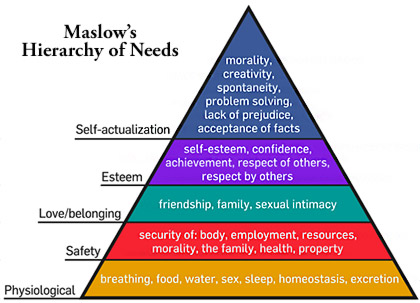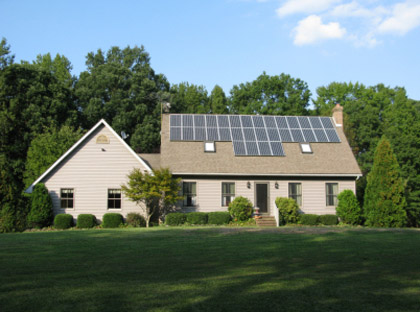Hierarchy of a Home Self-Actualization for House & Owner
Renowned psychologist Abraham Maslow said, “If you plan on being anything less than you’re capable of being, you’ll probably be unhappy all the days of your life.” His was a call-to-action for people to spend their lives striving for meaning and seeking to discover and become their best possible selves. I believe his Hierarchy of Needs theory can also be used as a call-to-action for homebuilders to apply their craft in pursuit of something greater than well-built structures, i.e., a “Hierarchy of Home.” Hierarchy of Home is a theory in construction proposed by – um – me that suggests in order for a home to realize its highest value and greatest potential, it must go through the steps of the hierarchy, just like Maslow’s theory, before emerging as a self-actualized home. At each and every level, application of green building technologies acts a catalyst to facilitate upward movement through the stages. Furthermore, it is only through these applications that a house can reach beyond self-actualization into self-transcendence, thus allowing its owner to do the same.
At the bottom of Maslow’s hierarchy are the basic biological, physiological and nutritional needs of human beings. At the bottom of the Hierarchy of Home are the basic needs that allow a home to be structurally sound – well-built footings, reinforced foundation and girders, floor joists, studs, rafters and sheathing made of conventional dimensioned lumber installed in a workmanlike manner. Such a structure will comply with minimal local building codes and pass framing inspections. Similarly, standard single-pane windows, asphalt roofing and vinyl siding will serve to provide protection from elements. However, a home built like this will struggle to progress upward in the hierarchy and will certainly never achieve self-actualization. It has incorporated too much wasted energy and too many wasted opportunities for more efficient performance.
To facilitate upward movement, this home would benefit from replacing its conventional lumber with engineered products, such as wood or steel, that are straighter, truer and more energy-efficient and quality-consistent. Framing the home’s exterior walls with “California” corners that leave space for insulation and replacing standard windows with double-pane, low-E, high-performance windows would allow for greater effective R-values and thermal protection. This home must challenge itself with a serious look at all its basic structural elements in order to not just survive but to progress upwards for the benefit of itself and its owners.

Photo Courtesy of Wikimedia Commons
The next level in Maslow’s hierarchy is “Safety,” which refers to the safety of the human body as well as general security and stability in life. This stage in the Hierarchy of Home represents the need for a home to be a haven for its owners to live in safety, comfort and good health. Of course, this has been achieved to some extent during the first stage but can be enhanced by items like window and door locks, HVAC and water systems with filters, detectors for CO, radon and smoke, and sanitary facilities that meet basic health department codes. However, a home that only provides these minimal protections for its owners will also struggle up the hierarchy. It will never self-actualize because it ignores the myriad health threats in homes.
Mold is a threat we are all aware of. But, we typically focus more resources on remediation than on prevention. A typical home specification provides for “green board” in showers, but this is of little value when water intrusion is a threat everywhere in a home. Also, many alternatives exist to paper-faced drywall that will not foster mold and mildew growth, such as fiberglass-faced gypsum boards or magnesium-oxide panels. These should be considered throughout the home. In addition to mold, VOC’s (volatile organic compounds) present a variety of short and long-term health threats. So, instead of just selecting paints by price and color, a home on its way to self-actualization will cover its interior walls with anti-microbial, zero-VOC and mildew-resistant paints. In some parts of the world where malaria presents a mortal danger, window screens with insecticide can literally be life-saving. Many green products, if properly built into a home, can go a long way to enhancing the health and safety of its owners. Only when a home has achieved both a high level of structural integrity and has incorporated safety components can it consider moving up the hierarchy to more esoteric pursuits.
The third level of need according to Maslow is “Love and Belonging,” which are psychological needs sought only after individuals have taken care of themselves physically. In terms of the Hierarchy of Home, this level refers to a home design that features amenities and specifications that make a house welcoming and comfortable to family and friends. These also convey the owners’ core values, which, of course, are only possible when a home is structurally safe and sound. In a house not seeking to self-actualize, this typically means amenities like generous kitchens with many appliances, large interior and exterior entertainment areas, hardwood flooring and architectural elements, which all create a great atmosphere to entertain. But, incorporating sustainable technologies can bring many of these amenities into another realm, which suggests the owners’ core beliefs in conserving natural resources. Nice landscaping can create an inviting entrance. But, when it is irrigated with gray water from the house, it is that much more impressive. Gigantic stainless steel appliances certainly add value, but most are now available in energy-efficient versions. A large sunroom can be a nice place to relax and read, but even more so if it is passively heated and cooled by maximally configuring the house relative to the sun. Additionally, rooms that are well-insulated are more thermally efficient and sound-resistant, thus enhancing privacy. Radiant-heated floors are a great feature, especially when they are run off geothermal power. At this level, the home is beginning to make real progress up the hierarchy, but is not concerned yet about achieving third-party recognition.
The fourth level in Maslow’s hierarchy is “Esteem,” which represents the need for a person to be recognized and respected for accomplishments. In the Hierarchy of Home, this is the level at which a home does, in fact, seek to be recognized and rewarded for its accomplishments. Typically homes seek recognition by sheer size or massive towers or expensive claddings, extensive interior and exterior upgrades, hot tubs or getting published in a design magazine. In a self-actualized home, recognition from these things is positive but not critical and not nearly enough. In such a home, recognition for energy efficiency by receiving an Energy Star certificate or even LEED-ratings, which result from rigorous third-party inspections for items such as duct leaks and general air permeability, would be preferable.

© iStockphoto.com/savone
This type recognition may lead to lower insurance premiums, availability of “green loans” for specific energy-efficient home improvements, as well as federal tax credits and rebates. Lower energy bills provide recognition of good decisions made during design and construction phases.
At the top of Maslow’s pyramid is “Self-actualization,” which occurs when individuals reach a state of harmony and understanding because they have achieved their full potential. At the top of the Hierarchy of Home, the self-actualized home is serving its owners as the best possible Manhattan apartment, country cabin, suburban house or whatever it was intended to be. Such a home will appraise at maximum value, the products in it will have a longer useful life and the house will establish itself as a leader in green design, engineering and construction. Such a house would generate power for itself in a clean and efficient manner while providing energy back to its neighbors via the grid. Applying Maslow’s theory, a house that plans on being anything less than it is capable of being will probably be underproductive all the days of its life, thus negatively impacting its owners.
Beyond self-actualization is self-transcendence, which comes from breaking through perceived limits, going beyond what we were meant to be, discovering how physically and spiritually high we can go. In the Hierarchy of Homes, this is the point at which homes no longer serve to maximize their own performance but the performance of surrounding homes, communities and the world either literally, through its preservation and production of resources, or figuratively, by providing a bold example of what a house should and must be.




























